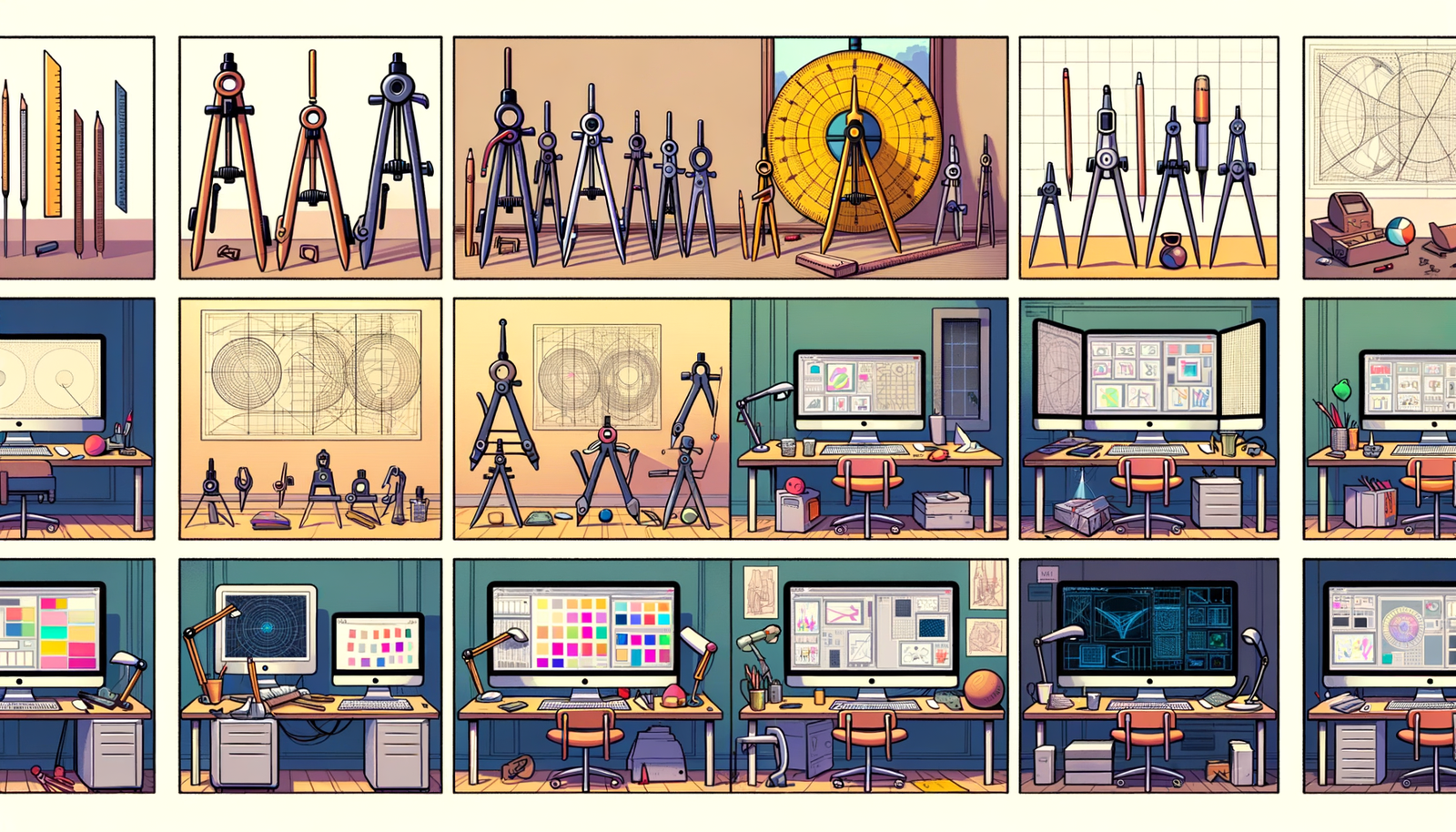Your Cart is Empty
Customer Testimonials
-
"Great customer service. The folks at Novedge were super helpful in navigating a somewhat complicated order including software upgrades and serial numbers in various stages of inactivity. They were friendly and helpful throughout the process.."
Ruben Ruckmark
"Quick & very helpful. We have been using Novedge for years and are very happy with their quick service when we need to make a purchase and excellent support resolving any issues."
Will Woodson
"Scott is the best. He reminds me about subscriptions dates, guides me in the correct direction for updates. He always responds promptly to me. He is literally the reason I continue to work with Novedge and will do so in the future."
Edward Mchugh
"Calvin Lok is “the man”. After my purchase of Sketchup 2021, he called me and provided step-by-step instructions to ease me through difficulties I was having with the setup of my new software."
Mike Borzage
Design Software History: The Influence of the Bauhaus Movement on the Evolution of Design Software and Its Lasting Legacy in Modern Design Practices
February 23, 2025 6 min read


Introduction to the Bauhaus Approach in Design
The early 20th century marked a transformative period in the realm of art and design, with the establishment of the Bauhaus school in 1919 standing as a pivotal moment in design history. Founded by the visionary German architect Walter Gropius in Weimar, Germany, the Bauhaus school emerged from the aftermath of World War I with a mission to unify art, craft, and technology. Gropius sought to bridge the gap between fine arts and practical crafts, fostering an environment where artisans and artists could collaborate towards creating functional yet aesthetically pleasing designs. This revolutionary approach was a direct response to the industrialization of the time, aiming to reconcile mass production with individual artistic spirit.
The Bauhaus philosophy was not just an educational curriculum but a radical movement that included prominent figures like Ludwig Mies van der Rohe and Marcel Breuer. Mies van der Rohe, who later became the school's director, was instrumental in advancing the school's ethos of "less is more," emphasizing minimalism and simplicity. Marcel Breuer, a student and later a master at the Bauhaus, made significant contributions with his innovative furniture designs, such as the iconic Wassily Chair, which embodied the school's principles by combining modern materials with sleek, functional design. Together, these key figures cultivated an environment that championed the integration of form and function, encouraging experimentation with new materials and techniques.
The core of the Bauhaus philosophy revolved around the concept of integrating art, craft, and technology to create designs that were both functional and beautiful. This integration was seen as essential in addressing the needs of modern society, where the rise of industrial manufacturing demanded a new approach to design. The school's curriculum was structured to provide students with a comprehensive education that covered various disciplines, including architecture, painting, sculpture, and industrial design. Workshops were at the heart of the Bauhaus educational model, where practical skills were taught alongside theoretical instruction, fostering a holistic understanding of the design process. This multidisciplinary approach not only revolutionized design education but also laid the foundation for modern design practices that continue to influence the industry today.
The Bauhaus Legacy in Early Design Software
The advent of digital technology in the late 20th century brought about significant changes in the way designers approached their craft, and the Bauhaus principles found new life in the digital realm. Early design software developers drew inspiration from the Bauhaus emphasis on functionality and simplicity, adapting these ideals to the emerging field of computer interfaces and digital design tools. The translation of Bauhaus aesthetics into software design was evident in the clean, uncluttered interfaces that prioritized user experience, making complex tools accessible to a broader audience.
Visual and functional design roots from the Bauhaus were apparent in early graphic user interfaces (GUIs) and software applications. Developers recognized that the minimalist approach advocated by the Bauhaus could enhance usability and reduce learning curves for new users. By incorporating grid systems and geometric layouts, software designers created intuitive environments that echoed the Bauhaus focus on order and clarity. This approach not only improved functionality but also established a timeless aesthetic that set the standard for software design.
Notable software examples inspired by Bauhaus principles include early versions of computer-aided design (CAD) programs like AutoCAD, developed by Autodesk in 1982. These programs emphasized precision and efficiency, allowing architects and engineers to create detailed designs with mathematical accuracy. The influence of Bauhaus alumni and adherents extended into the realm of software development through their contributions to educational institutions and technology companies. For instance, figures like László Moholy-Nagy, a former Bauhaus master, founded the New Bauhaus in Chicago, which influenced American design education and subsequently impacted the development of user-centered design principles in software.
Computational Adaptation of Bauhaus Ideals
The integration of mathematics and functionality in design software is a direct reflection of Bauhaus functionalism, where efficiency, precision, and usability are paramount. Design software leverages computational power to achieve the Bauhaus goal of uniting form and function. Algorithms and mathematical models enable designers to create complex shapes and structures with precision, embodying the Bauhaus ideal of combining artistic creativity with technical expertise. The use of geometric and grid-based layouts in software interfaces and design projects is a tangible application of Bauhaus principles, facilitating consistency, harmony, and balance in digital creations.
Moreover, modern design software brings craft and technology together by incorporating features that simulate traditional artistic techniques. For example, programs like Adobe Photoshop and Illustrator provide tools that mimic brush strokes, textures, and other tactile elements, allowing designers to infuse their digital work with a handcrafted feel. This fusion aligns with the Bauhaus vision of integrating craftsmanship with industrial production methods. Additionally, software platforms encourage multidisciplinary collaboration, much like the collaborative environment fostered at the Bauhaus. Tools like Autodesk Revit and BIM (Building Information Modeling) software enable architects, engineers, and designers to work cohesively on shared projects, streamlining the design process and enhancing communication among different disciplines. This collaborative approach not only improves efficiency but also enriches the creative process by incorporating diverse perspectives.
Bulleted list highlighting computational adaptations:
- Integration of mathematical models for precise design execution.
- Use of geometric grids to maintain consistency and alignment.
- Simulation of craft techniques through digital tools and features.
- Platforms supporting cross-disciplinary collaboration and teamwork.
The Continuing Impact of Bauhaus on Today’s Design Software
In today's digital age, the influence of the Bauhaus movement is more prominent than ever in design software that prioritizes clean lines, functional structures, and reduced complexity. Contemporary applications like Sketch, Figma, and Adobe XD embody Bauhaus ideologies by offering minimalist interfaces and focusing on user experience. These tools allow designers to create intuitive user interfaces and user experiences (UI/UX) that emphasize simplicity and usability, echoing the Bauhaus commitment to function over ornamentation. The prevalence of flat design and material design in modern software aesthetics can be directly traced back to Bauhaus principles, showcasing the movement's lasting relevance.
The impact of Bauhaus is also evident in digital architecture and product design software platforms. Programs such as Rhino 3D and Grasshopper enable architects and designers to explore parametric and generative design, utilizing mathematical algorithms to create organic and efficient structures. This approach mirrors the Bauhaus integration of art and technology, pushing the boundaries of what is possible in design through innovative use of software. Companies like Zaha Hadid Architects leverage these tools to realize complex architectural forms that are both functional and aesthetically striking, maintaining the Bauhaus balance between form and function.
Looking towards the future, the evolving impact of Bauhaus is expected to continue as design software integrates emerging technologies like artificial intelligence (AI) and augmented reality (AR). AI-driven design tools have the potential to automate routine tasks, allowing designers to focus more on creativity and innovation, a notion that aligns with the Bauhaus emphasis on freeing artists from manual constraints. Augmented reality offers new ways to visualize and interact with designs, blending the physical and digital worlds in a manner reminiscent of the Bauhaus goal to harmonize art, craft, and technology.
Predictions on future directions include:
- Greater incorporation of AI to enhance design efficiency and personalization.
- Expanded use of AR and virtual reality (VR) for immersive design experiences.
- Continued emphasis on user-centered design reflecting Bauhaus functionalism.
- Integration of sustainable design practices supported by advanced software tools.
Conclusion
The enduring influence of the Bauhaus movement on the design software industry is a testament to the school's revolutionary vision of uniting art, craft, and technology. The principles established by Bauhaus pioneers like Walter Gropius, Ludwig Mies van der Rohe, and Marcel Breuer have left an indelible mark on modern design practices, particularly in how software is conceived and utilized by professionals across various disciplines. By emphasizing functionality, simplicity, and user experience, Bauhaus ideals have shaped the development of software tools that enable designers to create meaningful and efficient work.
Maintaining a balance between artistic vision and technological functionality remains a core objective in contemporary design. The Bauhaus philosophy underscores the importance of this equilibrium, advocating for designs that are both aesthetically pleasing and practically effective. As software becomes increasingly sophisticated, the need to preserve this balance becomes even more critical to ensure that technological advancements enhance, rather than hinder, the creative process.
In reaffirming the Bauhaus as a timeless source of inspiration, it is clear that its principles will continue to guide innovation in design practices and software development. The movement's commitment to interdisciplinary collaboration, functionalism, and the harmonious integration of technology serves as a foundation for future advancements. As the industry moves forward, the Bauhaus legacy will persist, challenging designers and developers to create software that not only meets the demands of modern society but also enriches the human experience through thoughtful, inspired design.
Also in Design News

Cinema 4D Tip: Noise Shader Best Practices for Procedural Variation
October 31, 2025 2 min read
Read MoreSubscribe
Sign up to get the latest on sales, new releases and more …




